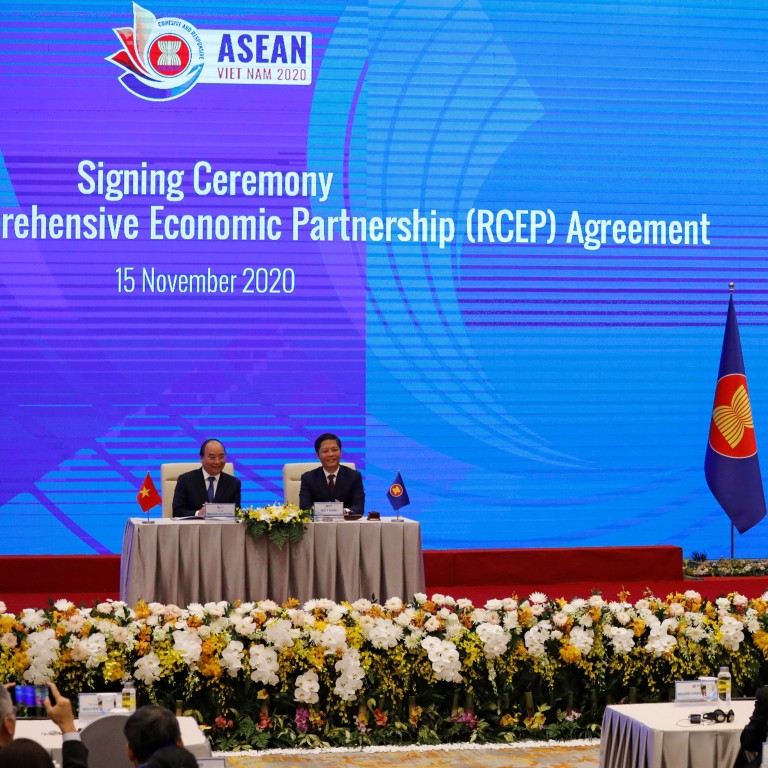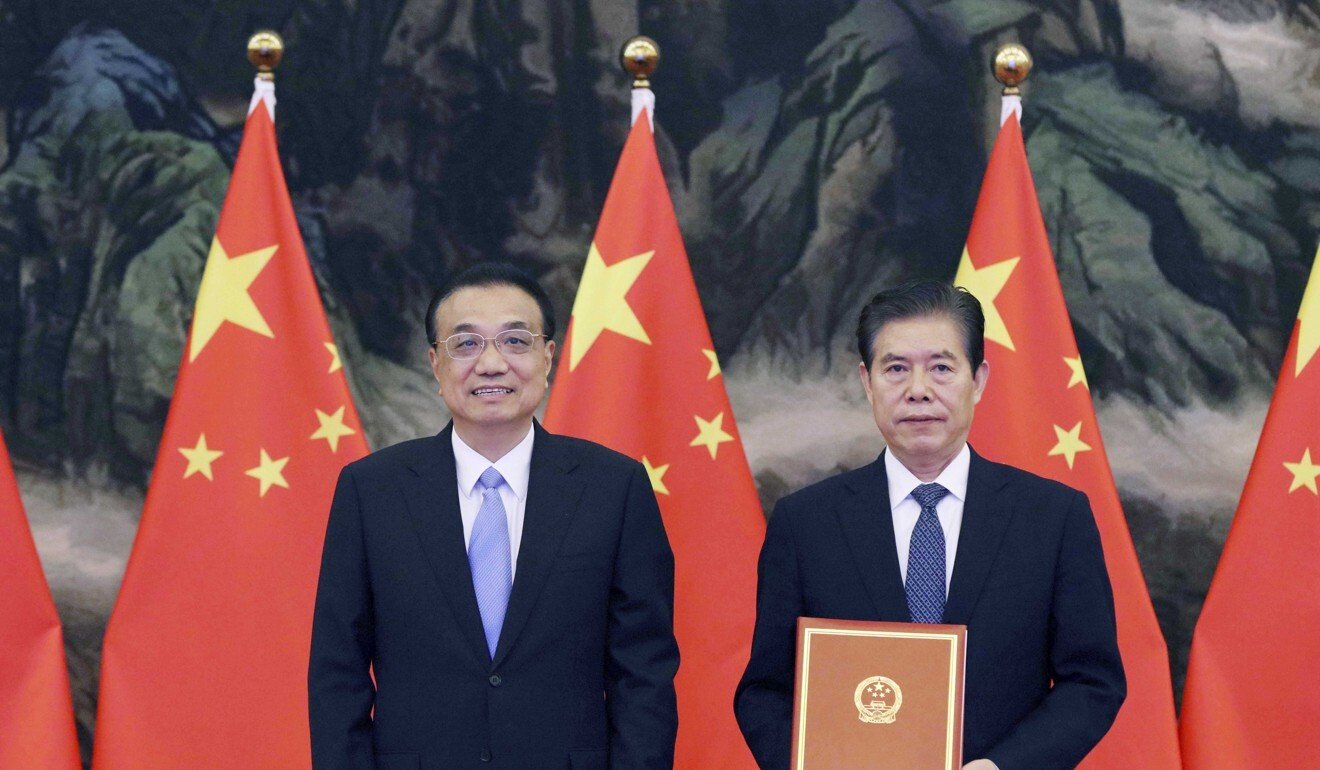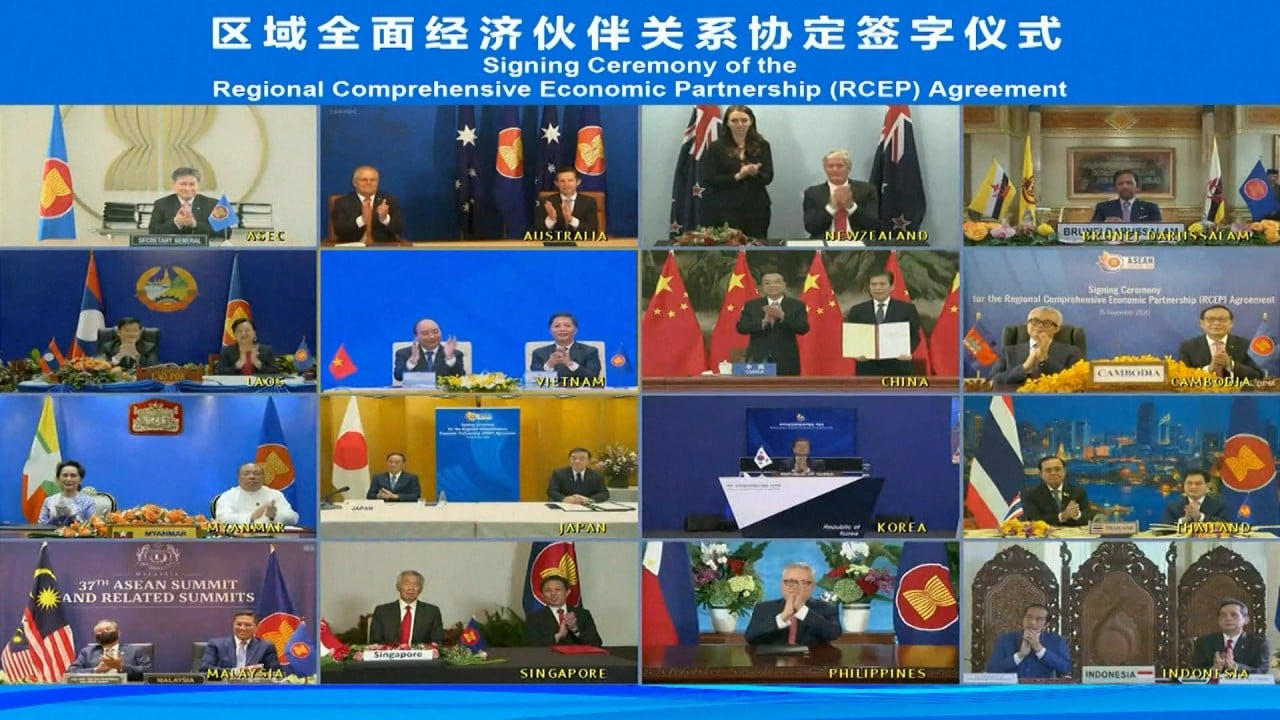
Why the RCEP trade deal could strengthen China’s hand in Asia as world waits to see what course US will take in future
- The United States has not signed the free-trade pact that includes three of Asia’s biggest economies and Asean member states
- Trade analysts say it is likely to give Beijing more influence over global trade and strengthen ties with neighbours
After eight years of negotiations, the 10 members of the Association of Southeast Asian Nations (Asean) plus Australia, China, Japan, New Zealand and South Korea signed the Regional Comprehensive Economic Partnership agreement on Sunday.
It was hailed as the world’s biggest trade deal, covering around 30 per cent of the world’s population and gross domestic product, and will establish common rules for e-commerce, trade and intellectual property.
It could come into force as early as next year and will eliminate up to 90 per cent of tariffs between signatories within 10 years of taking effect.
What is RCEP and what does an Indo-Pacific free-trade deal offer China?
It is the first multilateral free-trade agreement China has ever joined, and comes amid the ongoing economic turmoil caused by the coronavirus pandemic and heightened tensions between Beijing and Washington.
The deal also offers an alternative to the Comprehensive and Progressive Agreement for Trans-Pacific Partnership (CPTPP), which excludes China.
The previous US administration had wanted to join a previous version of CPTPP, known as the Trans-Pacific Partnership, but US President Donald Trump pulled out of the agreement after taking power in 2017.

The RCEP also forms part of Beijing’s efforts to recalibrate its trade relations with the fast-growing Southeast Asian economies.
On Friday, Premier Li Keqiang told Asean’s annual summit that the bloc had overtaken the European Union to become China’s biggest trading partner in the first three quarters of the year, although the United States remained the biggest single-country market.
According to a commentary published by Renmin University’s school of international studies, the deal is China’s biggest win in economic diplomacy since the formation of the Beijing-backed Asian Infrastructure Investment Bank in 2016.
“[It] displays that China’s economic cooperation with Asia-Pacific countries will be substantially strengthened, and significantly counter the numerous pressures from the China-US economic decoupling and changes in supply chains,” read the commentary, which was published on the China Economic Diplomacy Watch platform on WeChat.
However, it also highlighted risks to the RCEP’s future: for example, the possibility that the Biden administration would lobby allies such as Japan to withdraw.
Last year, India pulled out of the agreement, citing concerns about cheap Chinese goods entering the country.
World’s biggest trade deal signed – and doesn’t include US
Xu Liping, director of the Centre for Southeast Asian Studies at the Chinese Academy of Social Sciences in Beijing, said he believed the agreement would help strengthen multilateralism in the global trade order, and said the economic benefits meant it was unlikely that other countries would pull out for geopolitical reasons.
The RCEP is the first free-trade agreement involving China, Japan and South Korea – Asia’s first, second and fourth-largest economies respectively – and Xu said it was a “prelude” to a change in the global economic order that would give Beijing more sway in global trade.
“The RCEP signifies that there is a change in the export market in the global supply chain,” he continued.
“Considering the US-China trade tensions, and the uncertainties over trade with the EU, the RCEP gives China a new and committed market for trade which could ultimately change the global trade structure that has always seen Western countries as final trade destinations.”

02:10
China scores victory as 15 Asia-Pacific nations sign RCEP, the world’s biggest free-trade deal
Deborah Elms, a Singapore-based trade analyst and founder of the Asian Trade Centre, said the RCEP would not be a game changer for China because the country was already the biggest or second biggest trade partner of every nation in the region.
But she argued the pact would still bring benefits, saying: “It was less attractive ... in the past because the purchasing power of consumers in the region was lower and because trade costs remained relatively high.
“As these costs fall in RCEP and as the region has continued to experience economic growth, Asian trade for Asia makes more sense.”
She said it may also concentrate minds in Washington and Brussels, as American and European businesses risk missing out on the benefits that firms operating in RCEP countries will enjoy, such as “lower or eliminated tariffs, more access for services, improved access and protection for investments”.
‘Marginal’ RCEP gains will not offset trade war impact on China’s economy
Many political analysts are sceptical whether the new US administration will try to roll back trade sanctions on China or push hard to rejoin the trans-Pacific trade partnership, but Elms said it would have to “figure out something to remain economically engaged in the region”.
“They could, I suppose, try to join RCEP when it opens for new members in 18 months,” she continued. “Or they could try to re-engage with important Asian markets through CPTPP. Or they could craft a new economic approach, maybe based on the Indo-Pacific Strategy?”
The RCEP agreement touches on intellectual property, but does not cover issues such as environmental protections and labour rights – unlike the CPTPP, whose signatories include both RCEP countries, such as Japan and New Zealand, and North and Southern American states including Canada, Mexico, Peru and Chile.

